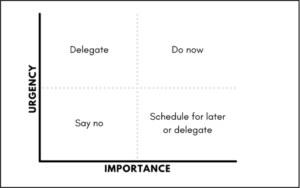Executive coach Lara Hogan uses a timeless approach to doing what’s most important to help clients cope when they feel overwhelmed at work. Covey’s Urgent/Important grid from The Seven Habits of Highly Successful People is one of the most valuable ways to think about your day and workload.
Here’s how it labels activities to see how your time is spent.

If a task is not urgent and not important, you have the opportunity – maybe even the obligation – to say no. Many people who get overwhelmed by their to-do list have trouble saying no. If they’re people-pleasers, they want to help and be liked for their helpfulness. This rubric allows people to say no by giving them a way to evaluate the relative value of their time and energy investment.
Lara Hogan writes, “Years ago; I heard someone say that leadership is about knowing which fires to let burn. Sure, you can groan; we all inherently know it’s true that we need to let some fires burn. But that doesn’t make it any easier.
The heart of this idea is that there will always be fires burning. It’s impossible to put them all out. As a leader, you’ll probably be reminded of them most days. And if you spend all your time trying to stamp out fires, you’ll never be able to look ahead, strategize, or grow and evolve. It’s your job to decide what fires to let burn.”
Quadrant two’s lesson is that if something is important but not urgent, you should schedule it, so you don’t overlook it or fail to get it done. Putting it on a calendar for a set date and time commits you to working on or finishing this important task. If it’s clear that you won’t be able to find the time to do it right, you can look for someone who can commit to it. You might find teammates who are eager to take on new responsibilities and skills or gain visibility. They will consider it an opportunity rather than a burden.
Delegation is an excellent way to manage your workload. Repeat after me: Delegation is an excellent way to manage my workload. Hogan writes: “Be sure to plot work [on the Urgent / Important gride] based on what’s true for you, rather than what you think you ‘should’ be doing. As soon as we start talking about ‘shoulds,’ this process falls apart.”
Suppose something is urgent but not important (administrative tasks and tasks from higher-ups that fell your way often fall into this category); you can delegate it to someone competent with a clear conscience. Get it done quickly and cross it off your to-do list.
That leaves the upper right quadrant: urgent and important. These are the tasks or projects that go right to the top of your list. Put your energy and time here, where it matters the most.
You’ll note that we called this post “The Eisenhower Matrix.” Here’s why. Dwight D. Eisenhower, the U.S. Army general who served as president from 1953 – to 1961, brought his military precision and clear priorities when he transferred to civilian governance. Eisenhower is first quoted as distinguishing between the urgent and the important in a 1961 speech to the Century Association. “Who can define for us with accuracy the difference between the long and short term! Especially when our affairs seem to be in crisis, we are almost compelled to give our first attention to the urgent present rather than to the important future.”
If you can master the Eisenhower Matrix, you’ll become happier and more productive at work.



